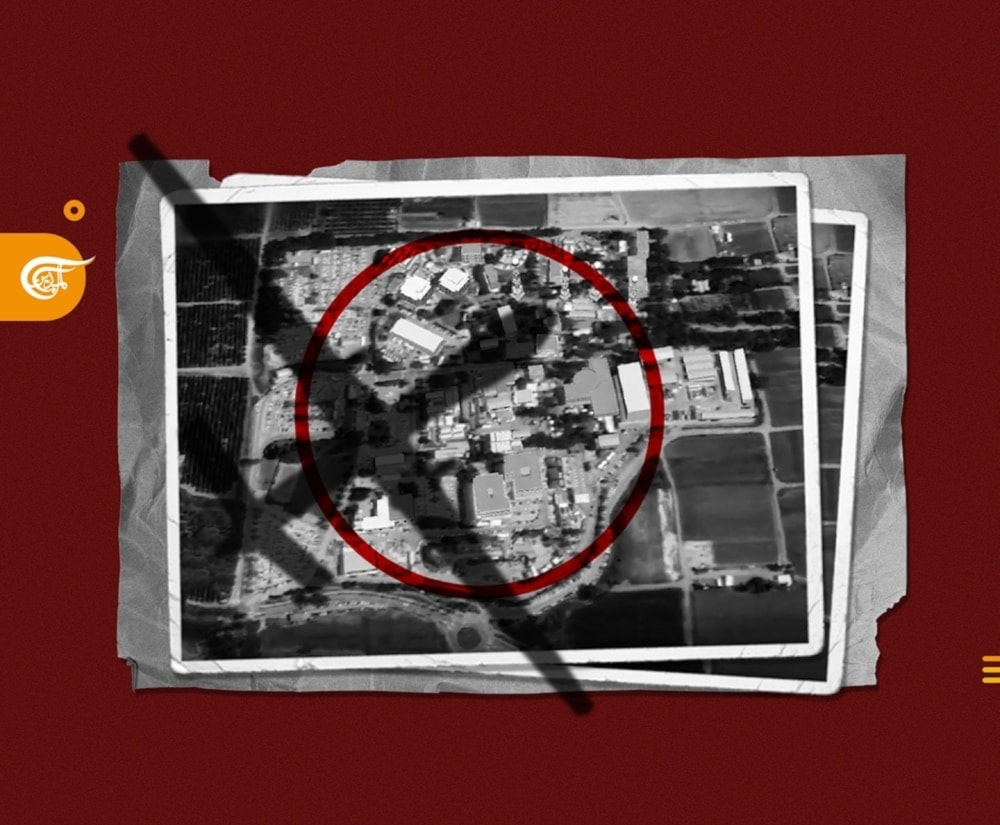Hezbollah's Op. Arbaeen 'complete success', drones struck Unit 8200
Informed sources tell Al Mayadeen that it has been undeniably confirmed that six Hezbollah drones hit their targets inside the Glilot base with high accuracy.
-

An illustration of a drone flying above the Glilot base (Al Mayadeen)
It has been confirmed from within the occupation entity that Hezbollah has indeed succeeded with Operation Arbaeen in reaching and striking the 8200 intelligence unit, informed sources told Al Mayadeen on Thursday.
The sources mentioned that at least six Resistance drones succeeded in penetrating the Israeli air defenses, adding that it has been undeniably confirmed that the drones hit their targets inside the Glilot base with high accuracy, prompting "Israel" to impose a tight security cordon around the base, extending several kilometers deep.
As part of Operation Arbaeen, Sayyed Hassan said in his speech on August 25 that the Islamic Resistance in Lebanon "targeted the Glilot base, which is a main base affiliated with the Aman military intelligence and which houses Unit 8200."#palestine#GazaGenocide#lebanon pic.twitter.com/pgylbLL6vr
— Al Mayadeen English (@MayadeenEnglish) August 26, 2024
This cordon remained in place for several hours, restricting access for both civilian and military personnel, the sources indicated.
Elsewhere, the sources told Al Mayadeen that, for Hezbollah, Operation Arbaeen has been a complete success beyond any doubt despite the complete Israeli security, military, and media blackout.
Informed sources have confirmed to #AlMayadeen that Hezbollah successfully executed #OperationArbaeen, which came in retaliation to the Israeli assassination of senior Commander Fouad Shokor, penetrating Israeli air defenses and directly impacting the 8200 intelligence unit.… pic.twitter.com/At4DHI2f98
— Al Mayadeen English (@MayadeenEnglish) August 29, 2024
Hezbollah confirmed on Sunday that it launched an "initial response" to the assassination of Commander Martyr Fouad Shokor by launching a large number of drones deep into the occupied Palestinian territories.
The Islamic Resistance in Lebanon clarified that the attack targeted a strategic Israeli military site.
Read more: Fact-check: Hezbollah's Secretary General debunks Israeli claims
Later, Hezbollah Secretary-General Sayyed Hassan Nasrallah announced that the primary targets of Sunday's operation were the central Glilot base of Israeli military intelligence Aman, incorporating the central hub of Unit 8200, located near Tel Aviv, and the Ein Shemer airbase.
In the wake of its military strikes in the first phase of its retaliation to the Israeli aggression on #Beirut on July 30, Hezbollah said that it successfully launched all its attack drones at the designated times from their respective launch sites.
— Al Mayadeen English (@MayadeenEnglish) August 25, 2024
Exclusive sources told… pic.twitter.com/gxoED8KPxV
He confirmed that "a significant number of drones hit their intended targets, but the enemy is keeping all relevant details concealed."
Sayyed Nasrallah explained that the operation entailed two phases. The initial phase was focused on targeting sites and barracks in northern occupied Palestine with the hundreds of intended rockets to exhaust and deplete the Iron Dome and interceptor missiles, which paved the way for phase two, which saw the swarms of drones heading toward their intended targets.
Hezbollah's Secretary-General debunks Israeli claims
In an attempt to hide its losses, the Israeli occupation military claimed that, in preemptive strikes, it struck "thousands of Hezbollah rocket launchers" by some 100 fighter jets. But Sayyed Nasrallah emphasized that the Israeli account of events was "full of lies," reflecting the inherent weakness of the Israeli entity.
He made it clear that the Resistance, with a clear and precise strategy, had no intention of using such weapons in this particular operation.
The Lebanese Resistance leader affirmed that "Israel" had no intel whatsoever, stressing that all its raids an hour before the operation were the result of the natural movement of Hezbollah's fighters on the ground in preparation for the operation.
He affirmed that "all the raids launched by the enemy did not target the area of operation" and did not have any impact whatsoever on Operation Arbaeen.
"Our initial plan was to launch 300 rockets in this operation, but we ended up launching 340," the Hezbollah chief indicated, affirming that the Israeli military "did not thwart anything."
"What was planned was achieved to the fullest," Sayyed Nasrallah asserted.
'Israel' misleading the public
Informed sources had also told Al Mayadeen that the Israeli occupation forces' claims of thwarting Hezbollah's operation are unfounded and are part of a broader effort to mislead the Israeli public.
In fact, despite the Israeli occupation's heightened state of alert and the presence of military aircraft over Lebanese airspace throughout the night, Hezbollah’s missiles and drones successfully reached their designated targets.
The Israeli narrative of preventing an attack involving over a thousand missiles, including precision-guided ones, is baseless and fabricated, the sources added.
Moreover, it has been confirmed that Hezbollah managed, after a month-long period of heightened Israeli alertness, to achieve its objectives despite the Israeli occupation's reliance on substantial American intelligence and operational support.
Read more: Hezbollah's retaliation I: Rockets, overwhelming firepower, and drones

 4 Min Read
4 Min Read








